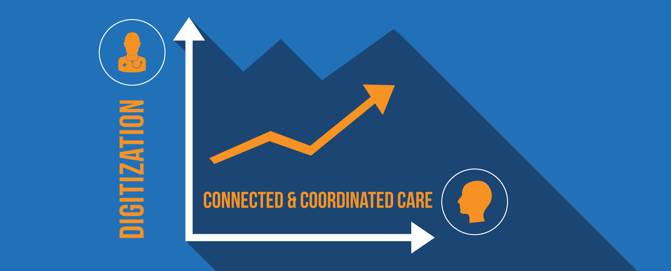
American healthcare is one of the last industry holdouts when it comes to fully embracing digitization. McKinsey Global Institute has ranked healthcare 19th out of 22 sectors in its oft-cited Industry Digitization Index.
Even as health systems implement digital health tools and practices, many of these technologies remain separate, leading to a disconnected patient experience.
But there is hope for the digitization of healthcare! Many digital health tools are designed to automatically link information from different digital sources, creating efficiencies that result in a better experience for patients and better workflows for staff.
Consider the typical digital hospital-patient relationship: One hospital department asks a patient to log into a portal to check lab results. Another uses an app for appointment reminders, and yet another sends digital health information to help manage patients' care.
This disparate sea of digital tools can be overwhelming and burdensome for both patients and providers, causing confusion and poor use of the resources the hospital provides.
Here are some ways you can improve care coordination by taking advantage of digitization without a lot of extra work on your part.
1. Connect your digital systems.
Different digital health tools have different purposes, and hospitals need multiple tools to accomplish their goals of improving health outcomes. But from the patient’s perspective, it’s all one connected topic: their health.
Through links, application programming interfaces (APIs) and other simple solutions, you can connect your digital tools to make it easy for patients to navigate between these resources, creating a seamless patient experience.
Learn about application programming interfaces for patient engagement.
2. Add a “push strategy” to your patient engagement.
Many health IT systems deal with protected health information (PHI) that must be locked behind passwords—information such as treatment plans, lab results and appointment history. Those systems use a “pull strategy,” one that depends on patients choosing to visit a website and logging in.
A push strategy, on the other hand, proactively sends information directly to patients. These messages contain population-based information and do not discuss an individual’s specific health details. With push strategies, the information is put right in front of patients—on mobile devices, for example. There is no need to remember website urls or passwords, and this increases access and use.
You can take your digitization to the next level by combining push and pull strategies. In other words, use your push messages to educate and engage patients, while also prompting them to visit the sites that contain their password-protected personal health information.
3. Use the data available to you.
Being digital, these tools inherently collect data that may provide insights into how your patients are doing, who is more at risk and who needs additional attention. This data may come from survey responses, secure messages, patient-reported feedback and other statistics and information.
The data enables significant improvements in care quality and customer service that, in turn, can improve patient satisfaction, drive meaningful patient relationships and discourage patients from searching online for potentially inaccurate health information.
Use your data to gain a better understanding of your patient population and to make your patient navigators’ work more efficient.
Act on that data by providing further resources to patients who need it, thereby encouraging them to become better partners in their care. Patient activation is proven to impact outcomes and cost of care.
Digitization is where healthcare is heading, even if at a slower pace than other industries. Going digital creates efficiencies for your team and your patients, and it ensures that you’re providing the right care resources in the most efficient way.








